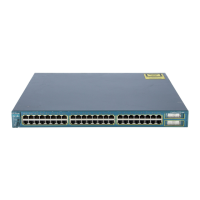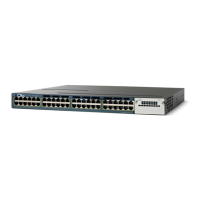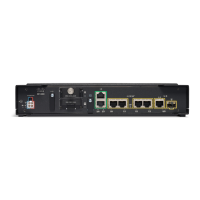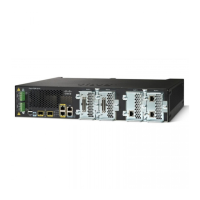1-6
Catalyst 3550 Multilayer Switch Software Configuration Guide
78-11194-09
Chapter 1 Overview
Features
–
Aggregate policing for policing traffic flows in aggregate to restrict specific applications or
traffic flows to metered, predefined rates
–
Up to 128 policers on ingress Gigabit-capable Ethernet ports
Up to eight policers on ingress 10/100 ports
Up to eight policers per egress port (aggregate policers only)
• Out-of-Profile
–
Out-of-profile markdown for packets that exceed bandwidth utilization limits
• Egress Policing and Scheduling of Egress Queues
–
Four egress queues on all switch ports. These queues can either be configured with the Weighted
Round Robin (WRR) scheduling algorithm or configured with one queue as a strict priority
queue and the other three queues for WRR. The strict priority queue must be empty before the
other three queues are serviced. You can use the strict priority queue for mission-critical and
time-sensitive traffic.
–
Tail drop and Weight Random Early Detection (WRED) techniques for avoiding congestion on
Gigabit Ethernet ports; tail drop for congestion avoidance on Fast Ethernet ports
Layer 3 Support (Some features and protocols require the enhanced multilayer software image.)
• Hot Standby Router Protocol (HSRP) for Layer 3 router redundancy
• IP routing protocols for load balancing and for constructing scalable, routed backbones:
–
Routing Information Protocol (RIP) versions 1 and 2
–
Open Shortest Path First (OSPF)
–
Interior Gateway Routing Protocol (IGRP) and Enhanced IGRP (EIGRP)
–
Border Gateway Protocol (BGP) Version 4
• IP routing between VLANs (inter-VLAN routing) for full Layer 3 routing between two or more
VLANs, allowing each VLAN to maintain its own autonomous data-link domain
• Multiple VPN routing/forwarding (multi-VRF) instances in customer edge (CE) devices to allow
service providers to support multiple virtual private networks (VPNs) and overlap IP addresses
between VPNs.
• Policy-based routing (PBR) for configuring defined policies for traffic flows
• Fallback bridging for forwarding non-IP traffic between two or more VLANs
• Static IP routing for manually building a routing table of network path information
• Equal-cost routing for load balancing and redundancy
• Internet Control Message Protocol (ICMP) and ICMP Router Discovery Protocol (IRDP) for using
router advertisement and router solicitation messages to discover the addresses of routers on directly
attached subnets
• Protocol-Independent Multicast (PIM) for multicast routing within the network, allowing for
devices in the network to receive the multicast feed requested and for switches not participating in
the multicast to be pruned. Includes support for PIM sparse mode (PIM-SM), PIM dense mode
(PIM-DM), and PIM sparse-dense mode.
• Distance Vector Multicast Routing Protocol (DVMRP) tunnelling for interconnecting two
multicast-enabled networks across non-multicast networks
• DHCP relay for forwarding UDP broadcasts, including IP address requests, from DHCP clients

